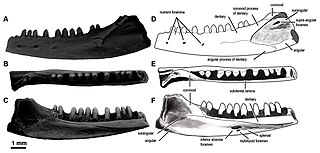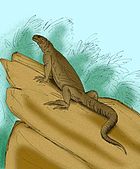Paracimexomys is a genus of extinct mammals in the also extinct Multituberculata order. Paracimexomys lived during the Cretaceous period. The few fossils remains come from North America. Some Romanian fossils were also tentatively assigned to this genus, though that classification now seems doubtful.

Sauroposeidon is a genus of sauropod dinosaur known from several incomplete specimens including a bone bed and fossilized trackways that have been found in the U.S. states of Oklahoma, Wyoming, and Texas.

Acrocanthosaurus is a genus of carcharodontosaurid dinosaur that existed in what is now North America during the Aptian and early Albian stages of the Early Cretaceous, from 113 to 110 million years ago. Like most dinosaur genera, Acrocanthosaurus contains only a single species, A. atokensis. Its fossil remains are found mainly in the U.S. states of Oklahoma, Texas, and Wyoming, although teeth attributed to Acrocanthosaurus have been found as far east as Maryland, suggesting a continent-wide range.

The Aptian is an age in the geologic timescale or a stage in the stratigraphic column. It is a subdivision of the Early or Lower Cretaceous Epoch or Series and encompasses the time from 121.4 ± 1.0 Ma to 113.0 ± 1.0 Ma, approximately. The Aptian succeeds the Barremian and precedes the Albian, all part of the Lower/Early Cretaceous.

Tenontosaurus is a genus of medium- to large-sized ornithopod dinosaur. It was a relatively medium sized ornithopod, reaching 6 to 7 meters in length and 600 to 1,000 kilograms in body mass. It had an unusually long, broad tail, which like its back was stiffened with a network of bony tendons.

Astrodon is a genus of large herbivorous sauropod dinosaur, measuring 20 m (66 ft) in length, 9 m (30 ft) in height and 20 metric tons in body mass. It lived in what is now the eastern United States during the Early Cretaceous period, and fossils have been found in the Arundel Formation, which has been dated through palynomorphs to the Albian about 112 to 110 million years ago.

Nuthetes is the name given to a genus of theropod dinosaur, likely a dromaeosaurid, known only from fossil teeth and jaw fragments found in rocks of the middle Berriasian age in the Cherty Freshwater Member of the Lulworth Formation in England and also the Angeac-Charente bonebed in France. As a dromaeosaurid, Nuthetes would have been a small predator.

Pycnonemosaurus is a genus of carnivorous theropod dinosaur that belonged to the family Abelisauridae. It was found in the Upper Cretaceous red conglomerate sandstones of the "Cabembe Unit", Mato Grosso, Brazil, and it lived about 70 million years ago during the Late Cretaceous.

The Cloverly Formation is a geological formation of Early and Late Cretaceous age that is present in parts of Montana, Wyoming, Colorado and Utah in the western United States. It was named for a post office on the eastern side of the Bighorn Basin in Wyoming by N.H. Darton in 1904. The sedimentary rocks of formation were deposited in floodplain environments and contain vertebrate fossils, including a diverse assemblage of dinosaur remains. In 1973, the Cloverly Formation Site was designated as a National Natural Landmark by the National Park Service.
The Antlers Formation is a stratum which ranges from Arkansas through southern Oklahoma into northeastern Texas. The stratum is 150 m (490 ft) thick consisting of silty to sandy mudstone and fine to coarse grained sandstone that is poorly to moderately sorted. The stratum is cemented with clay and calcium carbonate. In places the sandstone may be conglomeratic or ferruginous.
Kuwajimalla kagaensis is an extinct species of plant-eating lizard from the Early Cretaceous Kuwajima Formation in Japan. K. kagaensis is the type species.
The Hasandong Formation is an Early Cretaceous geologic formation in South Korea. It has been dated to the late Aptian and earliest Albian, between 118.0 ± 2.6 Ma and 112.4 ± 1.3 Ma. Dinosaur remains diagnostic to the genus level are among the fossils that have been recovered from the formation. Tracks of the pterosaur ichnospecies Pteraichnus koreanensis have also been recovered from the unit.

The La Pedrera de Rúbies Formation is an Early Cretaceous (late Berriasian to early Barremian geologic formation in Catalonia, Spain. The formation crops out in the area of the Montsec in the Organyà Basin. At the La Pedrera de Meià locality, the formation consists of rhythmically laminated, lithographic limestones that formed in the distal areas of a large, shallow coastal lake. It is noted for the exceptional preservation of articulated small vertebrates and insects, similar to that of the Solnhofen Limestone.

Obamadon is an extinct genus of polyglyphanodontian lizards from the Late Cretaceous of North America. Fossils have been found in the Hell Creek Formation of Montana and the Lance Formation of Wyoming. Researchers describe it as being distinguished by its "tall, slender teeth with large central cusps separated from small accessory cusps by lingual grooves." The type species was named Obamadon gracilis after United States president Barack Obama, "in reference to the tall, straight teeth, and the manner in which Mr. Obama has acted as a role model of good oral hygiene for the world." According to Nicholas R. Longrich of Yale University, the species "was probably a foot long, [and] with these tall, slender teeth it used to eat insects and plant matter."

Paramacellodidae is an extinct family of lizards that first appeared in the Middle Jurassic around 170 million years ago (Ma) and became extinct at the end of the Cretaceous around 66 Ma. It was one of the earliest groups of lizards to have undergone an evolutionary radiation, with members found across the supercontinent Laurasia. The phylogenetic relationships and constituent species of Paramacellodidae are uncertain. Many studies regard them to be scincomorphs, a large group that includes skinks and their closest extinct relatives, and possibly also to Cordyoidea, a group that includes spinytail lizards and relatives. Like modern skinks, paramacelloidids had rectangular bony plates called osteoderms covering most of their bodies, including their backs, undersides, and tails. They also had short and robust limbs. Paramacellodids are distinguished from other lizards by the combination two traits in their dentition, the teeth are labiolingually expanded at their bases, and the tooth apices are lingually concave.
Atokasaurus is an extinct genus of scincomorph lizard from the Early Cretaceous of Oklahoma. The type and only species is Atokasaurus metarsiodon, named in 2002 on the basis of a single isolated lower jaw bone found within the Antlers Formation in Atoka County. It is similar in appearance to extinct lizards in the family Paramacellodidae and may itself be a paramacellodid, although the phylogenetic relationships of the group are uncertain. Atokasaurus differs from other paramacellodids in having teeth in the lower jaw with enlarged bases and an S-shaped profile when viewed edge-on.
Bicuspidon is an extinct genus of Polyglyphanodontid lizard known from the Late Cretaceous of North America, Europe and Africa, two species, B. numerosus and B. smikros are known from the Cenomanian of Utah in the Mussentuchit Member of the Cedar Mountain Formation and the Naturita Formation respectively. While B. hatzegiensis is known from the Maastrichtian Sânpetru Formation of Romania and B. hogreli is known from the Cenomanian Kem Kem Beds of Morocco. An indeterminate taxon closely related to B. hatzegiensis referred to as B. aff. hatzegiensis is known from the Santonian Csehbánya Formation of Hungary. The dentition is heterodont, with conical anterior teeth and transversely orientated biscuspid posterior teeth.
Parasaurillus is a genus of extinct lizard from the Early Cretaceous of southern England. The type and only species is Parasaurillus pseudobtusus, named in 2002 by Susan E. Evans and Belinda Searle for extensive jaw and tooth material that has previously been classified as either Saurillus obtusus or Pseudosaurillus from the Berriasian Lulworth Formation. The taxon was found in the Mammal Bed near the base of the formation alongside the other lizards Becklesius, Dorsetisaurus, Durotrigia, Paramacellodus, Pseudosaurillus, Parviraptor and Saurillus obtusus. It is likely closely related to Scincoidea, more so than other contemporary taxa.
Pseudosaurillus is a genus of extinct lizard from the Early Cretaceous of southern England. The type and only species is Pseudosaurillus becklesi, named in 1967 by R. Hoffstetter limited jaw and tooth material from the Berriasian Lulworth Formation. A large amount of material that was additionally referred to Saurillus by Hoffstetter was reassigned to Pseudosaurillus in 1983 by Estes, but this has since been reclassified within its own genus Parasaurillus by Susan E. Evans and Belinda Searle in 2002. The taxon was found in the Mammal Bed near the base of the formation alongside the other lizards Becklesius, Dorsetisaurus, Durotrigia, Paramacellodus, Parasaurillus, Parviraptor and Saurillus. Like Becklesius, Pseudosaurillus may be a member of the family Paramacellodidae.











